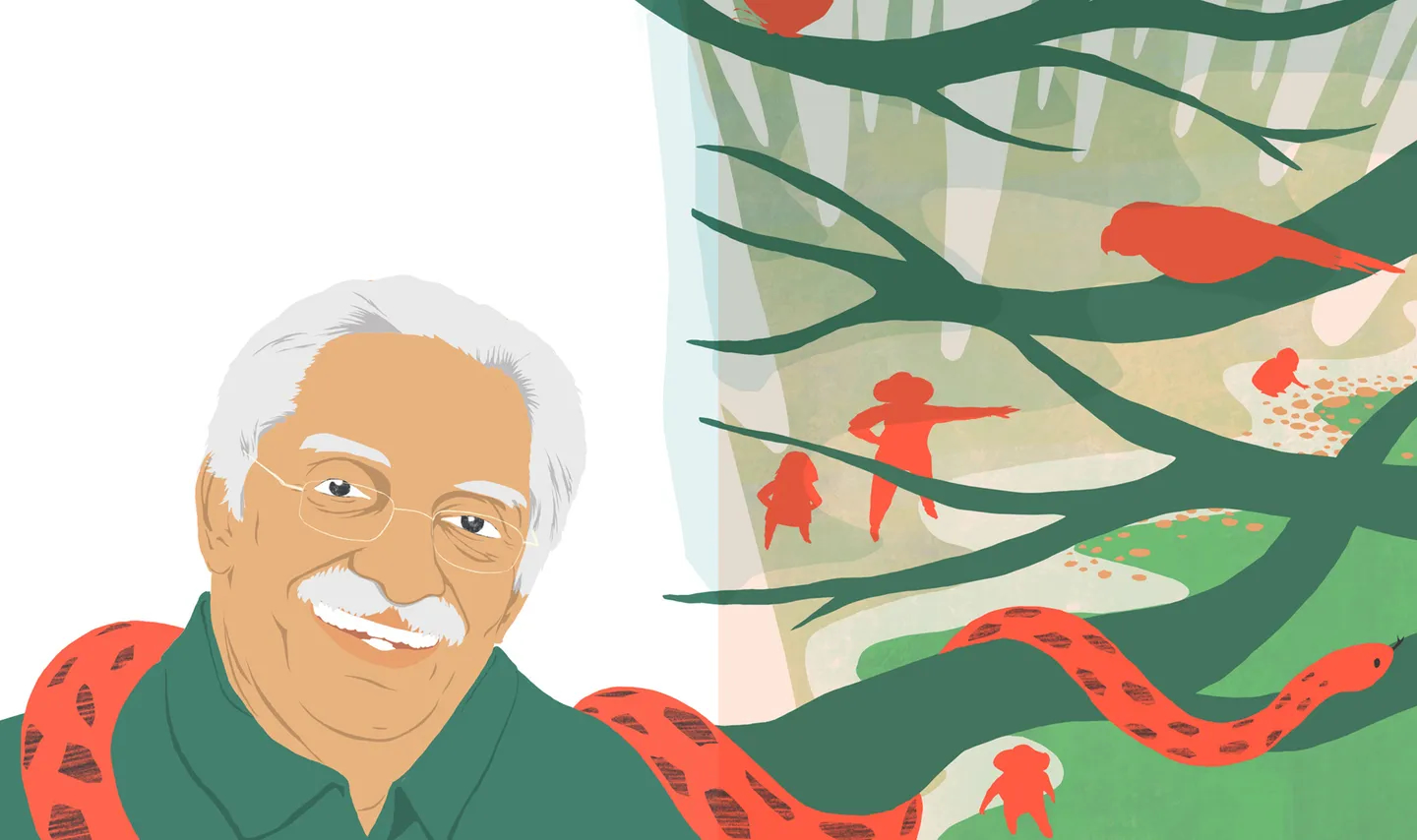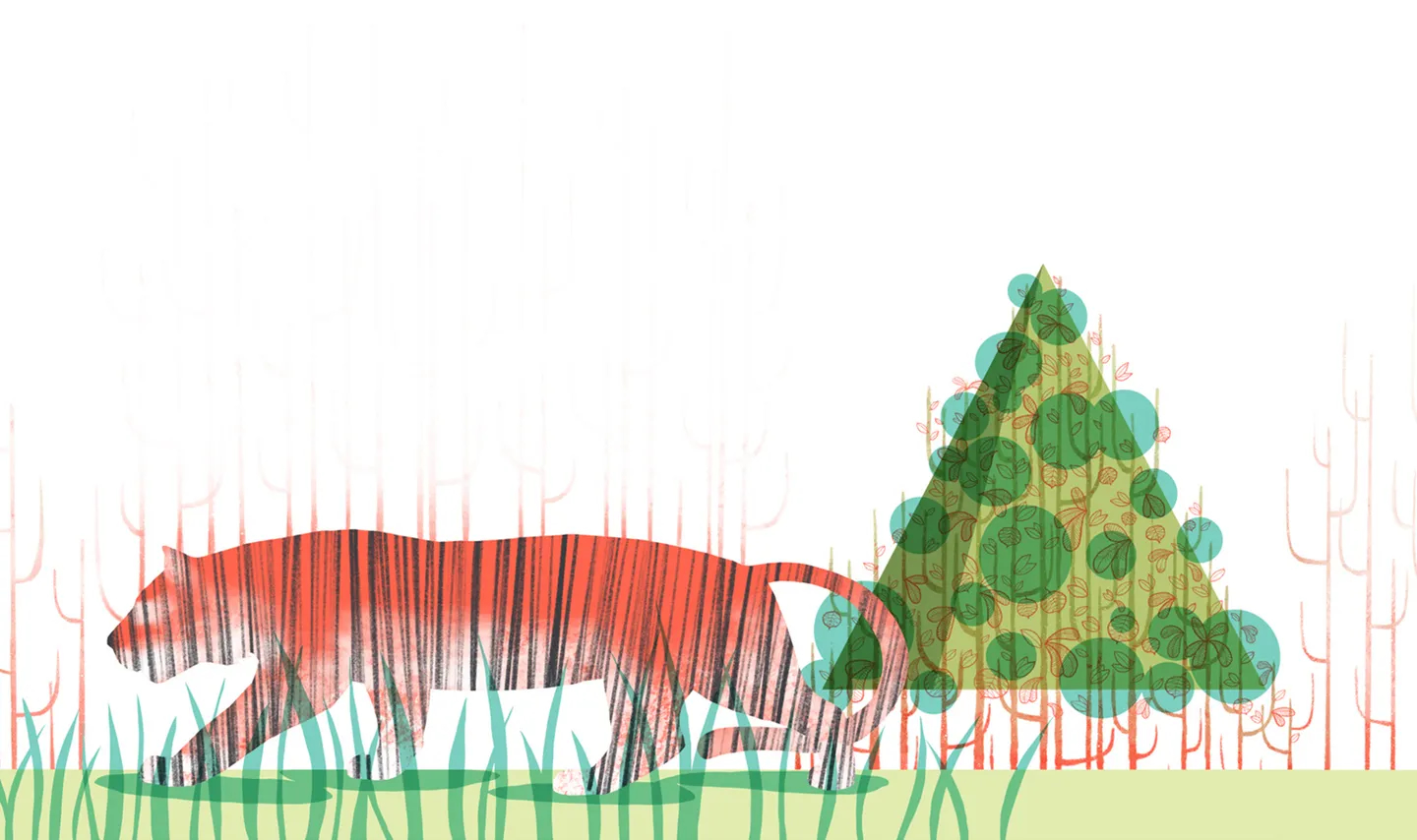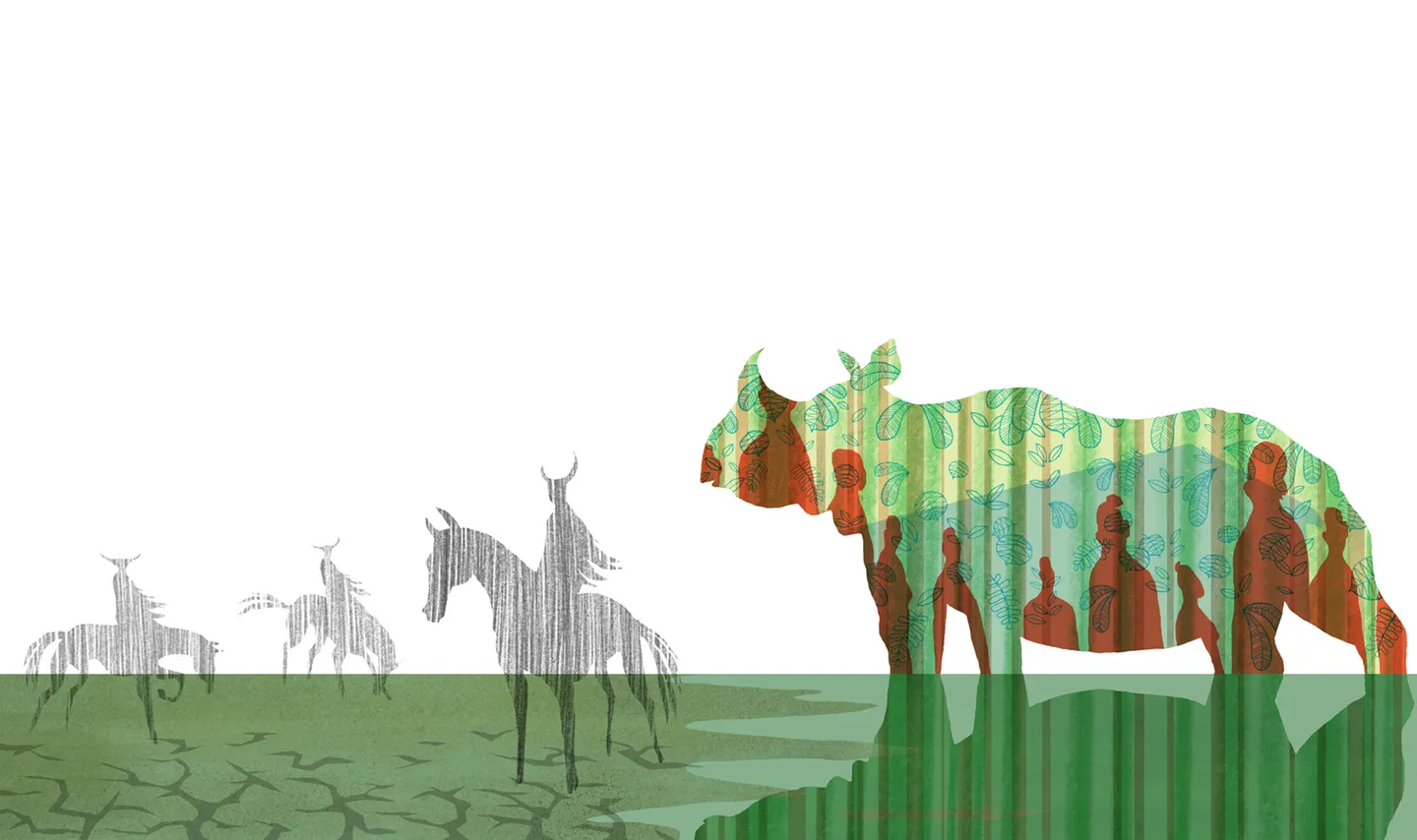Bittu Sahgal On Restoring The Balance Between Man And Nature
The founder and editor of nature and wildlife conservation magazine Sanctuary Asia highlights the issues endangering our country’s flora and fauna and speaks with Verve about the potential of the youth to catalyse a shift

A rare edition of the Bhagavad Gita is staring me in the face. The cover is a lovely creamish colour, and the title is etched in a font embellished with curves and swirls. Above where I’m sitting, taking up practically the entire wall, is a painting of a majestic elephant playing in a pond dotted with lily pads by painter Suneel Mamadapur. To my left, there are shelves lined meticulously with animal-shaped figurines. “I am not religious at all; if you were to ask, I’d say I’m a pantheist. But, the Bhagavad Gita is representative of so many things. I don’t see it as a religious discourse, but instead, as a guide on how one should live. I used to have long arguments with my grandmother because she was very religious and once asked me, ‘Why don’t you go to the temple?’ So I held on to a tree and replied, ‘This is my temple’.” Bittu Sahgal, founder and editor of India’s first and most widely circulated nature and wildlife magazine (and now online portal), Sanctuary Asia, dunks his green tea teabag into a white mug as he recounts the incident. His name has become synonymous with the outdoors, and he has dressed the part today — dark blue jeans with a camouflage-print olive T-shirt; his hair slicked back, with a white moustache to match; and his signature grin.
He generously offers me tea, coffee and toast, considering it’s tea time, before he motions for me to look at the bottom of his mug. It’s rather plain on the outside, but a closer look reveals an image of a polar bear sticking its head out from the inside base. “My daughter got me this,” he chuckles. I’m in Sahgal’s gorgeous home, which sits atop the leafy and unimaginably steep Dubash Lane in Mumbai’s Napean Sea Road for our interview.
Today, it’s impossible to mention the word ‘wildlife’ without bringing up Sanctuary Asia, a publication that has been documenting the country’s environmental issues since 1981.
A quick glance at the brand’s social media platforms will give you an indication of its massive reach: Sanctuary Asia has over 2,71,000 likes on Facebook; 59,000 plus followers on Instagram and 23,000 followers on Twitter; while the Sanctuary Nature Foundation group on Facebook has more than 1,95,000 members. These numbers haven’t just materialised out of thin air. The Sanctuary brand has, through its Sanctuary Nature Foundation, systematically implemented a number of projects and campaigns over the decades, and they work in accordance with the mission to drive change towards ‘abundant biodiversity, sustainable climate and a green future’. In addition to Sanctuary Cub (a magazine for children) and the Sanctuary Wildlife Awards, the foundation also runs Mud on Boots, a crowdfunded project that was started in 2017 to empower grass-roots-level conservationists.
But it was in 2000 that the brand first blew up, thanks to Kids for Tigers, an educational programme, which aims at turning children into eco-warriors by spreading the message that by saving the tiger, we are saving the planet. “In a sense, it’s a ‘trickle-up’ effect because, in order to save the tiger, you have to conserve the forest in the way that nature created it, and everything from the soil bacteria upwards is to be protected. Kids for Tigers is a handshake programme to educate children about the wonders of the world which are not a part of school curricula. And our strongest allies are the teachers,” states Sahgal.
He believes that in order to care for the planet, one must be educated from a young age. “Children have the greatest legitimacy to ask for a better future. Today, my arrogant, myopic and avaricious generation is doing the same thing as the East India Company — colonising India. Their brand of colonisation was geographical. Ours is intergenerational, which means that my generation is colonising the resources that belong to the future generations. Our India — including the economists, politicians and corporate heads — has forgotten almost all the lessons that our ancestors lived by and taught us. Only the young ones actually ‘get it’, and they can even understand complicated concepts about climate change and human rights. My firm belief is that we need an adult education campaign. A sort of ‘Each One Teach One’ programme, where it’s the children who are conscripted to explain simple ecological truths to the adults in their lives.”
But it’s hard to imagine that the Sanctuary Asia success story came about without any hiccups. Sahgal shrugs, “Setbacks? The worst are prior to every election, when ‘Give us your votes and pillage natural India’ becomes the mantra of virtually every politician. And then there’s the issue of people thinking that someone else is going to solve the problem.” That said, support from his wife Madhu and daughters Miel and Tara keeps him going. “I was trained by my daughters to be the change that I want for the world. And I can rely on them to tell me the truth,” he divulges.
He’s due to meet his grandchildren after I leave, and I can see his face light up when he talks about them. He also slips in his appreciation for what the Parsi Panchayat has done to protect the forested area of Napean Sea Road; thanks to them, peacocks, shikras and owlets regularly visit his courtyard.
As I walk down the slope on my way out, vibrant clusters of fuchsia bougainvillea overhead remind me of how beautiful nature can be. I spot a bunch of young boys playing a game of cricket. I see a chappal fly into a corner, and I dodge a rubber ball that bounces off a parked car’s bonnet. The scene is telling: it reminds me that the outdoors hasn’t been altogether forgotten. And just like that, it reaffirms my belief in the youth as well.

SCHOOL IS IN SESSION
Bittu Sahgal gives us a lesson in creating a more sustainable future…
THE WILD OUTDOORS
National parks versus zoos
“I cannot think of a better way to introduce our children to the different aspects of nature than to have them wander through the wildernesses in the company of naturalists, who love and understand both nature and the nature of children. Books are essential, but just one trip that might encourage a love for nature could actually motivate kids to read the ones that will fill them with knowledge. The Sanctuary brand has been doing this through our Kids for Tigers programme for well over 20 years, and we have triggered one-on-one nature interactions for thousands of children in the process. It is vital that the children are accompanied by people who revere nature, so they can feel like they are entering a temple and not a tourist spot. But I would avoid zoos altogether; they never ever had any legitimacy except in some very specific cases. And, as for those who suggest incarcerating animals helps in imparting an education in nature, they should also consider whether guided tours through prisons could convey the lesson that ‘crime does not pay’.”
INDUSTRY INTERFERENCE
Development versus sustainability
“At the outset, I would say that investments in public transport are good. But I am viscerally against short-cut-taking policymakers, who may choose the cheapest option of setting up a Metro car shed in Aarey Milk Colony, which would destroy an ecosystem that helps people to breathe in polluted, green-starved Mumbai. The problem is that we have planners, politicians, businessmen and bureaucrats who make the cardinal error of undervaluing grasslands, open spaces, mangroves, corals, or any such ‘infrastructures’ that are not man-made…they think these are of no use. But they are. You shouldn’t have to build one thing by destroying another as they are doing. If they had to, for instance, construct an infrastructure at Aarey or Sanjay Gandhi National Park…these already are infrastructures. So is Azad Maidan where, when the rain falls, the water seeps into the ground and feeds the aquifers which act as Mumbai’s freshwater reservoirs. Now, you destroy that reservoir by cementing it and building, say, a metro facility there…even if you green that cement by growing a garden, the water won’t percolate downwards. It will flood Chhatrapati Shivaji Maharaj Terminus and the municipal corporation building right opposite. I keep saying that the four horsemen of the apocalypse are ignorance, avarice, arrogance and public apathy. And as for the 2019-’20 interim budget, without going into details, let me just say that the amount of money that has been allocated to the Mumbai coastal road project is three times more than what has gone into protecting the entire nation’s environment — and this is being done in the name of economic development.”
MINISTERIAL MEDDLING
Politicians versus role models
“I would simply give politicians a single piece of advice — to change their damned ambition! We don’t necessarily want to get from one place to another faster, or travel up into the tallest building. What we want, really, is for our children to breathe clean air, eat safe food and live happy lives. When I hear these television debates, I switch off the TV because they’ve lost the plot even before they’ve started speaking. While getting from their homes to their offices these people are inhaling poisonous substances, and here they are talking about values. What values can you have if you’ve degraded your environment to the point where it is sucking the life out of you? I cannot point out one politician today and say, ‘Here is a Sarvepalli Radhakrishnan or a Rajendra Prasad’. I’m not even talking about Gandhiji or Nehru, but of those like Dr Bidhan Chandra Roy, who did much for society. Today, our ‘heroes’ are those who are plundering society, putting money into their personal bank accounts and becoming rich. I would change my heroes.”
ADVOCATES OF CHANGE
Power versus influence
“[Actor] Dia Mirza and others like her, who have large followings and share our values, are vital ambassadors for our mission. The video she directed for the Kids for Tigers initiative has reached vast audiences, and we have held hundreds of screenings across India. She is also on the Sanctuary Nature Foundation board. Dia is a very authentic person; she’s in the business of acting, but her feelings for nature are for real. We look up to those in the spotlight, so it’s doubly important for well-known and well-respected people to do the right thing instead of just saying it. In general, nature is very forgiving. But if we cross the line, it can punish us, and we are approaching that point now. My advice to people who want to help protect nature has always been, ‘Be who you are and do what you do best’. If you’re a poet, write poetry. If you’re a journalist, write reports. If you’re a celebrity, use your credibility and reach. If you’re a politician, use your influence. If you’re a businessperson, use your organisation skills. When many of us do a little bit, a lot gets done.”
LOCAL LEANINGS
Tourism versus conservation
“India has fantastic opportunities to create livelihoods through the restoration of nature. We have mountains, deserts, plains, grasslands, wetlands, coasts, corals and more. Now, the people whose cultures have evolved among these ecosystems would be the biggest beneficiaries of their conservation. We (at Sanctuary) have come up with a concept called COCOON Conservancies (Community Owned Community Operated Nature Conservancies). All too often, after 30 years spent protecting a degraded forest and seeing its wildlife bounce back, I have seen someone buy some land to set up an ‘ecolodge’. There’s nothing intrinsically wrong with that, but they are not really doing anything substantial for that forest…. If, for instance, somebody from the city wants to go see Kaziranga National Park’s rhinos, why should they not have that experience in a situation where the local people are the primary beneficiaries? India has lost half a million farmers to suicide in the last 15 to 20 years — that is an abysmally shameful number. We would love to restore their farms to their natural state and ensure that the ownership of the now-vibrant forest land is retained by the farmers. I think that the only way to make wildlife tourism truly meaningful is to make sure that the local people benefit from it…and I also think that we need technology to organise visits better. A hundred people landing up at Tadoba National Park when only 30 cars can enter at a time — that’s when bribery and corruption take root.”
A GUT FEELING
Healthy diets versus eating right
“I’m experimenting with veganism. If I were to describe myself, I would not call myself an animal rights person in the narrow sense, but a ‘species rights’ person. I don’t eat things that bark or gambol, for the same reason that you wouldn’t take a bite out of socks or a wastepaper basket — I don’t associate them with food, and this includes fish and birds. But that’s one part of the picture. If you look at what America has done to the dairy industry — it now causes almost as much damage to the earth as the meat industry does because they both clear rainforests to create grasslands to feed the animals they rear. Very often, they are feeding animals to other animals. I’m not suggesting that the Inuit people should start eating carrots — living in the polar regions, it would not be possible. But for the rest of us, our eating habits are prime drivers of climate change, and climate change is going to be the hammer used by nature to either break our knees or force us to follow its diktats.”

BEGIN AGAIN
Sahgal’s list of must-read works, must-hear songs and must-watch TV series…
Life on Earth: A Natural History (1979), a BBC series narrated by David Attenborough, for waking the urban world to the wonders of the natural world.
The lyrics of the song Masters of War (1963) by Bob Dylan, for exposing the peddlers of war as effectively as anyone can ever hope to.
The Superannuated Man from the Last Essays of Elia (1833), by Charles Lamb. Because, among other things, it speaks of the joy of nature and the futility of counting money.
Silent Spring (1962), a book by Rachael Carson, a woman ahead of her time who blew the whistle on pesticide peddlers.
The Sense of Wonder (1965) by Rachel Carson. Because we’ve lost that sense of wonder.
The Bhagavad Gita, which I keep going back to, not so much for its literal advice, but for the truth it so powerfully conveys: that the gift of life should be cherished and not be squandered by chasing false dreams of grandeur.
Yuval Noah Harari’s 21 Lessons For The 21st Century (2018).
Indica: A Deep Natural History of the Indian Subcontinent (2016) by Pranay Lal.